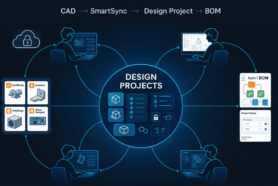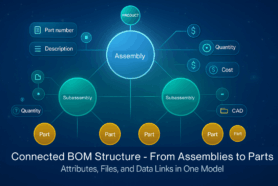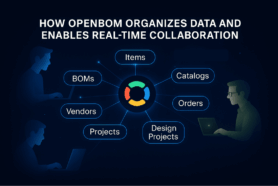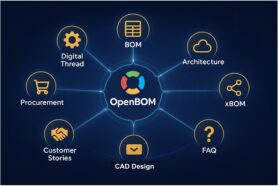
Hello there! If you’re reading this, you’ve probably taken the first step toward managing your engineering data more efficiently by creating a free account on OpenBOM.
Congratulations! Now that you’re on board, you might be wondering, “What’s next?” Well, fear not, because I’m here to guide you through five essential steps to get the most out of OpenBOM immediately after signing up.
When you have a hammer, all problems look like nails. Paraphrasing it, to most companies coming to use OpenBOM, all problems look like a spreadsheet. Together with the file/folders paradigm, spreadsheets are one of the strongest data management paradigms that exist in the engineering world. If I give a problem to engineers, they will come to me in 20 min with Excel that solves the problem.
I wrote a bunch of articles about how to “escape Excel thinking”. You can find them here:
Bill of Materials (BOMs) – Three Steps To End Excel Data Mess
BOM Management – How To Escape From Old Excel Ideas?
Bill of Materials Best Practices – How To Leave Excel BOM Templates Behind You?
Before we dive into the specifics, let me remind you of three important things to keep in mind:
- OpenBOM is not an Excel storage solution; it’s a data management platform. You won’t be dealing with documents; you’ll be managing data.
- Unlike your typical Excel spreadsheet, OpenBOM connects data using Part Numbers, BOMs, and various relationships.
- Don’t think of OpenBOM as a “black box processor” with Excel input and output; it’s a comprehensive data management platform designed to transform the way you handle your product data.
With that in mind, let’s explore the five crucial actions to take after registering with OpenBOM:
Step 1: Assess Your Data Needs
I understand the excitement of exploring a new tool, but before you start clicking buttons, take a moment to consider the data you need to manage. Ask yourself questions like:
- How will you identify parts with unique part numbers?
- What defines the products you’re developing?
- How many different part types do you have?
- What are your composition rules, such as simple assemblies, multi-level structures, or configurations?
Having clarity about your data needs will set the stage for effective data management with OpenBOM.
Step 2: Identify Existing Data Sources
In OpenBOM, a basic data set consists of three elements: items, catalogs, and product structures (BOMs). You’ll need to organize your data in a way that allows you to define multiple items using at least one catalog and combine BOMs from these items. You can do this manually by defining all the records, including Part Numbers, attributes, and files, or you can opt for automatic data import (which we’ll discuss in the next step).
Step 3: Install CAD Add-In and Import Samples
OpenBOM offers powerful integrations that allow you to capture data directly from CAD systems. Start with a small project, install the CAD add-in, and click on the “BOM” button. This will generate a preliminary BOM, and the items will be stored in the default catalog. It’s a great way to get a feel for OpenBOM’s capabilities.
Step 4: Import Non-Design Data
Once you’ve imported CAD data, you can explore adding more information, such as vendor details, pricing, and descriptions. Try importing some additional item data from Excel to see how flexible OpenBOM is, allowing you to expand your data properties and integrate them with existing CAD output.
Step 5: Add More Data and Manage Changes
Experiment with OpenBOM’s data management capabilities by capturing changes, creating historical records, and managing revisions. This will give you valuable insights into how OpenBOM streamlines your data management process.
By following these steps, you’ll have successfully initiated your journey toward efficient data management with OpenBOM. Now, it’s time to consider taking the next step by reaching out to OpenBOM, exploring subscription options, and scheduling an onboarding meeting.
Conclusion:
OpenBOM can be your go-to tool for generating BOMs, extracting data from CAD systems, and exporting files to Excel and Zip formats. However, it’s more than just that; it can fundamentally transform your data management paradigm. Instead of wrestling with spreadsheets and documents, start thinking about the data itself—items, part types, assemblies, and interconnected information like specs, links, and files. With OpenBOM, you can create rich datasets and gather data about your products, making data management a breeze.
Remember, paradigm shifts take time and effort, but OpenBOM is here to support you every step of the way. Identify the first three challenges in your company or processes, and think about how OpenBOM can help you solve them.
If you have any questions or need assistance, our sales team is eager to chat with you.
So why wait?
REGISTER FOR FREE, and let’s get started on your data management journey with OpenBOM today.
Best regards,
Oleg
Join our newsletter to receive a weekly portion of news, articles, and tips about OpenBOM and our community.










